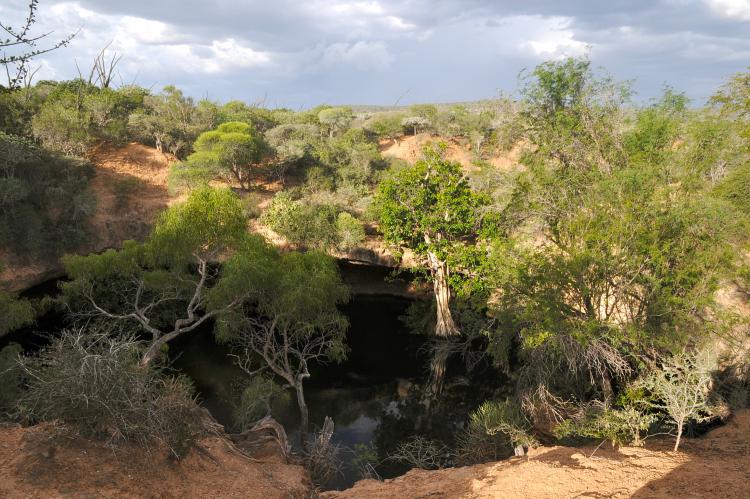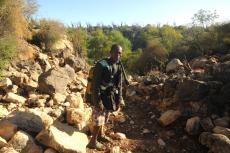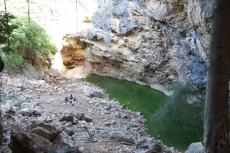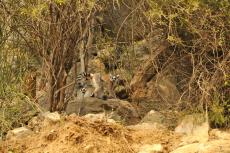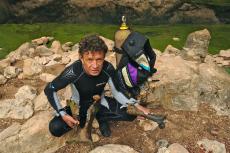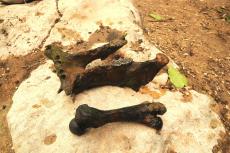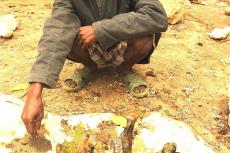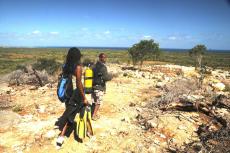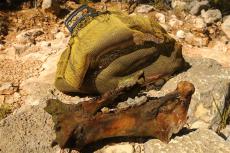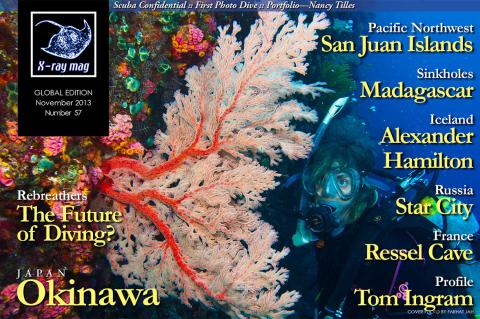Madagascar: Sinkholes & Caves on Mahafaly Plateau
Stretching west and north of the Isalo Ranges, the Mahafaly Plateau runs like a dragon’s tongue to the very tip of Madagascar’s southwest coast. This is a remote country in the Great South, where numerous historical shipwrecks have lain below the waves since the 16th century.
Tags & Taxonomy
The Mahafaly Plateau has been affected by post-Eocene tectonic movements with a northwest-southeast distension, which tops an older tectonic event on the underlying substrate. Seismic activity is a common occurrence there. The karst process is intense in the lower Eocene with very deep caving systems, whereas in the mid-Eocene, sinkholes are only visible.
A number of these sinkholes, or avens as they are locally known in the French language, were brought to light by aerial photography taken by the French (Battestini 1964, IGN 1966). Looking like cauldrons, these collapsed sinkholes, round or oval in shape, measure anything from a few dozen metres up to 500 metres in diameter, with depths ranging from 40m to over 100m. They are natural wonders that make one hold one’s breath for a minute.
Tsimanampetsotse National Park
Crossing the Bay of St Augustine on a flat sea, our speedboat made a beeline to Anakao, a Vezo fishermen village under the sun. The white beach was fringed by a turquoise green lagoon, cradled between the historic Nosy Ve Island and the mainland. It looked like a picture perfect postcard, with local outrigger canoes sailing back and forth on their fishing trips—an impression of paradise rediscovered.
A coastal track follows the west coast 56km to Efoetsy—gateway to Tsimanampetsotse National Park, whose exquisite Malagasy name means, “there are no dolphins”. A nature reserve created in 1928 during the French colonial administration, the park is comprised of a huge lake—15km long and 2km wide—equaling a surface of 3,750 hectares, home to two species of flamingoes. The natural reservoir is fed by the springs coming out of the cliff, and by the avens as well.
A few caves and spectacular sinkholes are found in the park, home to giant banyans. Amazing roots climb down into the holes in search of water.
At Mitoho Cave, a small lake hosts some albino Eleotrid blind fish—pink and white—of the Typhleotris genus. These small creatures timidly skim the surface.
The hour-and-a-half loop circuit of Tsiamaso (meaning “without eyes” and related to spirits) allows access to the cave of Andranolovy where a huge five-stemmed Madagascar palm tree (Pachypodium geayi) guards the entrance.
A stone’s throw away, one comes to the aven of Vintany where a curtain of roots of the aviavy tree spill down like a waterfall to the existing water table. A bit further along, the lone baobab (Andansonia rubrostipa), or “grand mère”, puffed up and covered with open warts, stands still like a matriarch lost in time.
The dirt road continues south into white sand, across an arid, sun-parched countryside. The spiny bush is a landscape composed of almond green silver thicket (Euphorbia stenodacla), with thorny branches, and rather exotic octopus trees of the Didieracae genus, which look like candelabra cactus. However, their trunks are made of wood, covered with spines and also tiny leaves.
Itampolo
The town of Itampolo, a name meaning “ten cameleons”, is another two hours further. Beyond the picturesque fishing village and the idyllic beach on the waterfront, the attraction here lays in the existence of two sinkholes worth visiting.
Avintany, in the lowlands, is an aven ten metres deep, full of water and accessible only through the roots of an aviavy tree. The clear water of the lake is enticing. The cream coloured limestone cliff is quite hard, present with flintstones, sandstone and sedimentary tuffs.
A second aven named Androinpany is found 5km inland, on the top of the Mahafaly Plateau, hidden in a forest of spiny Alluaudia, a species of octopus tree. Androinpany is a circular pit, 15 metres across, with sheer walls that plunge down to 66 metres in one drop. Impressive enough, it is inhabited by a couple of maki lemurs, which live in cracks near the entrance of the sinkhole. The site is also home to rather inquisitive black vasa parrots and a couple of kestrel falcons.
“Some years ago, two Portuguese men came here with ropes and climbed down to the bottom,” said our guide, Dongary. I could make out a pile of debris at the centre of the sinkhole, with a ring of water indicating a possible cave underground.
Intrigued by these fascinating sinkholes, I returned to Itampolo four times in the course of two years.
Avintany sinkhole
At Avintany, which is 34m by 22m across, I lowered a scuba tank and dive equipment with a rope and a camera in a bucket, then climbed down the roots of the aviavy tree like a lemur ‘holding onto dear life’. The initial snorkel around the pit indicated a depth of 10m around a central mound crested with green vegetation—a mini forest of stems with whiskers.
Prehistoric looking, brownish copper blindfish, Typhleotris mararybe, (identified as a new species in December 2012) with a duck beak, swam about under the overhangs in the shallows, together with what looked like an aquatic mantis (water scorpion). Streams of bubbles rose from the sedimentary floor in places, proof of ancient volcanic activity.
Subsequent scuba dives revealed caves in the north, south and east ends. The larger, most accessible being the former one, which extended to 80m over a lunar landscape of silt ridges, down to a depth of 25m.
Bumping into a solid wall at the far end, I noticed a deeper passage that sank down to 30m, in a sort of bottleneck crowned with white sediments—a ‘no-no’ for a solo diver to attempt. At the top of the passage, dug into the silt, I gazed upon some blackened bones—vertebras of what could be an elephant bird (Aepyornis) or a crocodile tail.
For the Malagasy people, these avens are fady, which means taboo or sacred in the local tongue. Locals are afraid of them, for they believe dreadful spirits inhabit them. Others come here to practice rituals—including the sacrifice of a black rooster or a goat—and bring offerings, such as a bottle of rum, cigarettes or money. “Women pray for fecundity, in the hope to have a child,” I was told. (...)
Download the full article ⬇︎
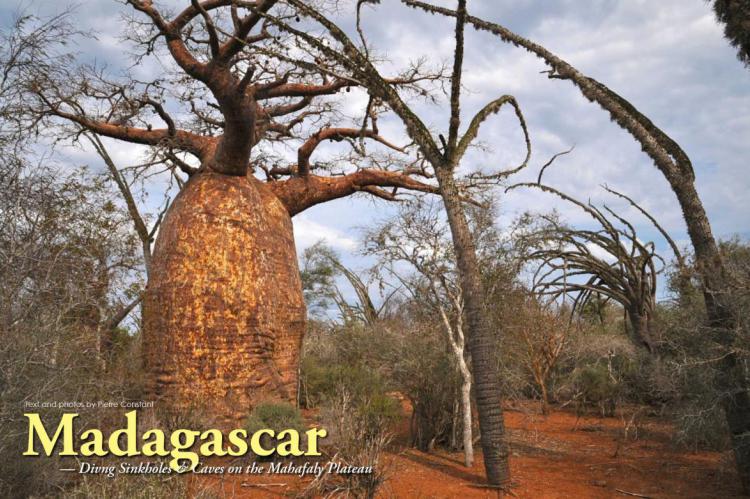
Originally published
X-Ray Mag #57
Diving Okinawa in Japan; Exploring sinkholes in Madagascar; Diving the San Juan Islands of Washington State; Expedition to the Alexander Hamilton in Iceland; Are Rebreathers the Future of Diving; Expedition to Ressel Cave; Disabled diving in Russia's Star City; Interview with Tom Ingram; Nancy Tilles portfolio; Scuba Confidential with Simon Pridmore; Plus news and discoveries, equipment and training news, books and media, underwater photo and video equipment, turtle news, shark tales, whale tales and much more...


